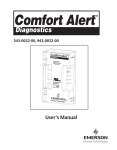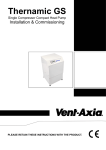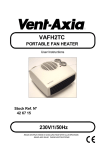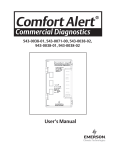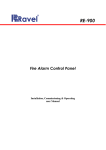Download Vent-Axia VAUFHTC User manual
Transcript
User Manual 1. Product description - Area of use. . . . . . . . . . . 2. Technical data. . . . . . . . . . . . . . . . . . . . . . . . . . . 3. Explanations of the symbols in display . . . . . . 4. First time the thermostat is turned on. . . . . . . 5. Operation of the thermostat. . . . . . . . . . . . . . . 5.1. Constant temperature mode . . . . . . . . . 5.2. Event based mode. . . . . . . . . . . . . . . . . . 5.3. View measured sensor values. . . . . . . . . 6. Changing settings. . . . . . . . . . . . . . . . . . . . . . . . 6.1. System settings. . . . . . . . . . . . . . . . . . . . . 6.2. Sub-settings, parameters . . . . . . . . . . . . 6.3. Event mode settings . . . . . . . . . . . . . . . . 6.4. Setting the clock . . . . . . . . . . . . . . . . . . . 6.5. Setting the timer . . . . . . . . . . . . . . . . . . . 7. Error messages. . . . . . . . . . . . . . . . . . . . . . . . . . 8. Resetting the thermostat. . . . . . . . . . . . . . . . . . 2 3 5 5 7 8 8 11 11 11 12 14 16 17 18 18 Installation instructions 19 1 1. PRODUCT DESCRIPTION – AREA OF USE Thermostat for regulating underfloor electric heating cables, temperature range within +5 to +40 °C (default). Ref 446174 is programmable, and regulate the room or floor temperature automatically. The thermostat can operate in two modes, constant temperature mode or event mode. From the factory Ref 446174 will start and run in constant temperature mode using the room sensor (internal sensor) by default. The temperature is set by the user, according to his/her needs at any given time. If switched to event mode the temperature target will be changed according to the default program as shown in section 4. In event mode the thermostat controls the temperature according to time and day. For weekdays and weekend, different temperatures can be set at different times. In this way it is possible to reduce the output during night and day when the user does not need comfort temperature (automatically). Energy consumption can be reduced considerably. Please see section 6.3. for settings and event mode programming. The thermostat has a (built-in) room sensor and is delivered 2 with an external sensor which should be placed (embedded) into the floor between two heating cable loops, near the floor surface. Temperature can be regulated by the floor sensor or the room sensor. A combination mode is also available where both sensors are used. The floor sensor can then be used to limit the floor temperature (below the set maximum limit), the room sensor is used for regulating temperature according to the set value. If the heat indication symbol is shown in the display, it means the thermostat is heating, but the symbol is not directly linked (synchronized) to the relay controlling the power to the heating cable. The thermostat is turned on and off by using the ON/OFF button. When turned off the settings will be remembered. The thermostat will also remember its' settings if the power supply fails (no time limit, EEPROM backup). 2. TECHNICAL DATA Rated voltage 220-240V Own consumption <2W 3 Maximum load 16A(approx. 3600W at rated voltage) Switch (ON/OFF) Electronic Temperature range Designed working temperatures From +5°C to +40°C (+41°F to +104°F) (default) 1-50 °C (Room sensor) for sensors 1-80 °C (Floor sensor) Dimensions 84x84x40mm(25 mm socket) Encapsulation IP 21 Length floor sensor cable Cross section area, connecting wires Max. number of heating cables 3m 0,5 mm² - 2,5 mm² 3 Sensing element NTC Display LCD (blue backlighting) The thermostat is maintenance free. 4 3. EXPLANATION OF SYMBOLS IN DISPLAY Clock (*) Day of week (*) Measured, or set temperature if “SET” is shown. Antifreeze (*) Heat indication symbol. Room sensor (*) Event/operation mode symbols(*) Floor sensor (*) Shown if override is active Timer (*) Shown when setting events/modes. Shown when adjusting general settings * These symbols are only shown if the function/state is active. 4. FIRST TIME THE THERMOSTAT IS TURNED ON When the Ref 446174 is powered ON for the first time the following will be shown in the display (heat indication shown according to temperature level): 5 The thermostat is in constant temperature mode. If switched to event mode the following predefined program will start running: MONDAY - FRIDAY: Start time for normal operation 06.00 Temperature 21°C (morning) Start time for day saving 09.00 Temperature 16°C operation Start time for evening operation Start time for night 17.00 Temperature 21°C saving 22.00 Temperature 16°C operation 6 SATURDAY - SUNDAY: Start time for normal operation 08.00 Temperature 21°C (morning) Day saving operation(deactivated -- .-- Temperature -- °C by default) Evening operation(deactivated by -- .-- Temperature -- °C default) Start time for night saving 22.00 Temperature 16°C operation For adjusting settings and other operational possibilities please see section 5 and 6. 5. OPERATION OF THE THERMOSTAT To change between constant temperature mode and event mode This function is linked to the clock function. Enter general settings (See section 6.1) and go to sub-setting 11:CL (clock settings). If the clock is disabled, the thermostat will run in constant temperature mode. Event mode is activated by activating the clock itself, either 12h AM/PM or 24h (See section 6.1). 7 5.1. Constant temperature mode The display will show the sensor in use and the temperature (or the set temperature according to settings, see section 6.1 and sub-setting 12:DF default display). The set temperature can be adjusted by the user by pressing the UP and DOWN buttons. 5.2. Event based mode The temperature is regulated dependent of time and day (as set by the user). 8 In this mode the display will show the sensor in use, the clock, the current event (in this case "evening operation"), the temperature (or the set temperature according to settings, see section 6.1 and sub-setting 12:DF default display), and the present day (in this case Saturday). In event mode of operation the thermostat regulates the temperature according to four different events (the user can define time and temperature for all four): normal operation / morning day saving operation (the habitants leave the house) evening operation (the habitants return to the house) night saving operation For MONDAY to FRIDAY: Normal operation (morning) From time A to B Day saving operation From time B to C Evening operation From time C to D 9 Night saving operation From time D to A For SATURDAY to SUNDAY there are two different events by default (up to four events can be activated): Normal operation (morning) From time E to F Day saving operation (not defined by default) Evening operation (not defined by default) Night saving operation From time F to E The times and temperatures of all events can be programmed by the user, please see section 6.3. Event mode of operation can be overridden by the user. This is done manually by setting a new temperature with the UP and DOWN buttons. Leave the thermostat and it will return to override mode after 10 seconds, OVERRIDE is now shown in the display. The thermostat will regulate the temperature according to the override value until the next event starts. The override can be cancelled manually by pressing the CLOCK button once (wait 10 seconds). 10 5.3. View measured sensor values This function is only available if sub-setting 12:DF = 01, see section 6.2. Further on, you cannot see the measured value of a sensor that is not active, according to sub-setting 10:SE, see section 6.2. Press and hold CLOCK button for 3 seconds to see measured value of floor (external) sensor. (SET symbol will disappear). Press and hold ON/OFF button for 3 seconds to see measured value of room (internal) sensor. (SET symbol will disappear). 6. CHANGING SETTINGS 6.1. System settings First, turn the thermostat OFF, then press and hold the UP and DOWN buttons (5 seconds) until the following is shown in the display. 11 Sub-setting number Abbrevation for setting Current parameter, which can be adjusted. This is the menu for general settings, containing 12 different sub-settings. Sub-setting 01:CF is shown first. Pressing the CLOCK button lets you cycle between the other 12 different sub-settings. UP and DOWN keys adjust the current parameter as shown in the display. 6.2. Sub-settings, parameters 01:CF Set whether to show temperatures in Celsius or Fahrenheit degrees. 00=Celsius, 01= Fahrenheit. 02:DI Shows the dead band range. For information only, the value cannot be changed. 03:CA Calibration. You can manually set the value of the current measured temperature. This setting/value applies to 12 both internal and external sensor. 04:FR Antifreeze function. 00=Off, 01=On. If function is on the antifreeze symbol will be shown in the display. See also sub-setting 05. 05:FS Temperature limitations, antifreeze and maximum floor temperature. 05=Basic antifreeze, the thermostat will start heating if the temperature goes below 5 degree Celsius. CU=User defined settings. Minimum limits as set in sub-setting 06 and 08 will be used for antifreeze purposes. In addition if both sensors are active (sensor mode 02) the thermostat will limit the maximum floor temperature (using the floor sensor max value) according to the value set in sub-setting 09. Active sensor according to setting 10:SE will be used for temperature measurement. If sensor mode=02 the room (internal) sensor will trigger the antifreeze function. 06:RO Defines valid minimum setting/value for room temperature. 07:RO Defines valid maximum setting/value for room 13 temperature 08:FL Defines valid minimum setting/value for external/floor temperature. 09:FL Defines valid maximum setting/value for external/floor temperature. 10:SE Sensor selection. 00=Room sensor, 01=Floor sensor, 02=Both, combination mode. Set active sensor(s) according to installation instructions. 11:CL Clock. NO=No clock, thermostat will run in constant temperature mode, 12h=12 hour clock with AM/PM, 24h=24 hour clock without AM/PM displayed. If either 12h or 24h is active, event mode will also be activated. 12:DF Default display of temperature: set or measured temperature. 00=display measured temperature, 01=display set temperature. Leave all buttons for 10 seconds to save all settings and return to normal operation mode. The ON/OFF button cancels and exits the settings menu. 6.3. Event mode settings 14 With the clock activated see section 6.1, you can change the settings for event mode of operation. Press the CLOCK button once and the following will be displayed: You are now adjusting settings for weekdays Monday to Friday, “Normal operation (morning)”. The start-time will be blinking, and it can now be changed with UP and DOWN buttons. Press CLOCK button once to jump to the temperature and use UP and DOWN buttons to set the temperature for this event/timeframe. In other words time A (see section 5.2) is set first, thereafter the temperature for this timeframe. The end time of each timeframe is defined by the start time of the next timeframe. Press CLOCK button again to jump to next event, and thereby defining time B (see section 5.2), and thereafter the other events. After all four events are defined the settings for 15 Saturday and Sunday is defined the same way. For Saturday and Sunday day saving and evening operation is disabled by default indicated by "- -" symbols. During programming, if no buttons are pressed for 10 seconds settings will be saved and display will return to default display. Pressing ON/OFF button will cancel and return to default display. 6.4. Setting the clock Press DOWN and CLOCK button simultaneously for 5 seconds to set the clock (clock must be active, sub-setting 11:CL). The following will be displayed: The hour is set first. UP Increases value of blinking parameter DOWN Decreases value of blinking parameter 16 CLOCK Goes to the next setting (minutes, then finally selection of day) Leave the thermostat for 10 seconds and all adjustments will be saved. Press ON/OFF button to cancel. 6.5. Setting the timer If you want the thermostat active at certain timeframe each day you can use the timer function. Press and hold UP and CLOCK buttons simultaneously for 5 seconds to enter timer setup: First, startup time is defined. Use UP and DOWN buttons to adjust blinking value, and use CLOCK button to jump to next value. After startup time is defined, end-time is defined. Leave all buttons for 10 seconds and settings will be saved. The thermostat will now switch on during the defined interval, at 17 other times it will be off. Set the startup-time equal to the end-time to disable the function. 7. ERROR MESSAGES If there is a fault associated with a sensor either E1 or E2 will be displayed flashing, along with an indication of which sensor is faulty. E1 means the sensor connection is short-circuited. E2 means there is an open circuit at the sensor connection. For example, the message below indicates a short-circuit at the internal room sensor. 8. RESETTING THE THERMOSTAT To reset the thermostat to its’ original factory settings turn it off, 18 then hold ON/OFF button and UP button simultaneously for 10 seconds. All LCD symbols will then light up and the default data is recovered. Release the buttons. INSTALLATION INSTRUCTIONS Vent-Axia VAUFHTC Ref 446174 Product description VAUFHTC Ref 446174 is a digital thermostat for controlling electrical underfloor heating cables. The thermostat is equipped with an integrated room sensor and is delivered with an external (floor) sensor. The thermostat shall be mounted in a standard junction box. Technical data Rated Voltage: 220-240V, 50/60 Hz Max. load: 3600 W (16 A at 230 VAC) IP class: IP 21 19 Temperature range (default): +5 to +40 °C Max. circuit breaker size: 16 A Length of floor sensor: 3m Cross section of cold lead: 0.5 mm² - 2.5 mm² Max. No. of heating cables: 3 On/off-switch: Electronic Norms/standards: IEC 60730-1 and IEC 60730-2-9 EMC Directive 89/336 The device is CE-marked. For indoor use only. Warranty Vent-Axia offers a 2 year warranty on defects in material and workmanship in the sold product, under proper use and service. In case of a defect, Vent-Axia will repair or replace the product. The warranty does not extend to defects caused by a faulty installation or improper use. Vent-Axia must be given written notice of any defect within 30 days after the defect was discovered. Further, a detailed description of the defect must accompany the claim in order for the warranty to be valid. 20 Before installing the thermostat Determine whether the heated floor shall be controlled by using the room or floor sensor. For guidance, see table 1. Both sensors can be set active. The room sensor will then be the primary sensor, and the floor sensor can function as a temperature limitation sensor, protecting the floor from overheating. Please see user manual for further details. The thermostat should be positioned approx. 1.6 m above the floor. If the room sensor is used, the thermostat must be positioned so that air freely can flow through the thermostat chassis. Avoid placing the thermostat in places where it will be exposed to direct sunlight or draught. Make sure that the heating cable’s cold lead reaches the planned position of the thermostat. If installing floor sensor: Start by following the instructions in section 1. For installation with room sensor only: Proceed directly to section 2. IMPORTANT: All wiring to be in accordance with the current I.E.E regulations, or appropriate standards of your country and MUST be installed by a suitably qualified person. 21 All heating cable circuits shall have a 30mA ground fault circuit interrupter installed. IMPORTANT: Before installing the thermostat, the power circuit must be disconnected on phase and neutral. This is done by switching off or unscrewing the circuit breaker(s). Verify with a voltmeter that the circuit is completely disconnected by measuring phase – neutral, phase – ground, and neutral – ground. Table 1 Room type Concrete floor with tiles, stone or slate, high area load (100 150 W/m²) Bathroom Washroom Toilet Wet rooms in general Floor Room Room Recommended + sensor sensor floor heating cable sensor products from (limita Vent-Axia tion-se nsor) X VAUFHC VAUFHM100/15 0 22 Concrete floor with tiles, stone or vinyl, low to medium area load (60 - 100 W/m²) Living room Kitchen Hall Sleeping room Living areas in general Concrete floor with parquet or laminate, low to medium area load (60 – 100 W/m²) Living room Kitchen Hall Sleeping room Living areas in general Wooden floors, dry solutions (no need for concrete/screed). Low area load 50 – 100 W/m² Living room Kitchen Hall Sleeping room Living areas in general X VAUFHC VAUFHM100/15 0 X X* VAUFHC VAFHM100/150 X X* VAUFHC VAFHM100/150 * Required by some parquet/laminate suppliers. 23 1. Installation of the floor sensor 1.1 The floor sensor shall be positioned centered between two heating cable strings in the floor before pouring concrete or screed. It is recommended to install the sensor in a flexible conduit. The conduit should cover the full sensor length. Seal off the conduit in the (floor) end to prevent concrete or screed from entering. It is recommended to position the conduit/sensor as close to the floor surface as possible (fig. 1) 1.2 Feed the sensor into the conduit so that the sensor itself is positioned near the end of the conduit in the floor. 1.3 Proceed to section 2. 2. Installation of the thermostat 1.4 Verify that the supplying circuit is completely disconnected. 1.5 If the heating cables are installed in a wet room (for example bathroom), the thermostat shall be placed outside the room. For dry rooms, the thermostat can preferably be placed inside the room. If the heating cables shall be 24 controlled by using the room sensor, the thermostat must be placed inside the room. 1.6 Separate the frontside (screen) and the backside (socket) by pressing lightly on the top middle (opening mechanism), see fig. 2. Place the screen somewhere safe. 1.7 Connect the heating cable to the connectors 5 and 6 (fig. 3) 1.8 Connect the power supply (L and N) to the connectors 4 and 7 (fig. 3) 1.9 If the floor sensor shall be used, It shall be connected to the connectors 1 and 2 (fig. 3) 1.10 Connect the heating cable’s earth conductor to the building’s earth using an approved connector or connect them together in connector 3 (fig. 3). REMEMBER! Heating cables shall always be connected to earth. 1.11 Put the backside (socket) in place into the junction box and fasten by using mounting screws. 1.12 Attach the frontside (screen). CAUTION! Be very careful when attaching the frontside so the pins don't get bent. The connector (8 pins) shall fit exactly into the slot. Place 25 the frontside into the tracks at the bottom first, then align the pins so they start going into the slot correctly, then press the entire cover into its' final position. 1.13 See the enclosed user manual for operation, programming of day/night function, clock setting and general setting adjustments Fig. 1: Positioning of the floor sensor 26 Fig. 2: Attaching and detaching the frontside (screen) from socket Use Screw Driver to open the plastic housing. Slot to align pins into. BE CAREFUL! Pins must go correctly into slot. Fig. 3: Thermostat back side 27 Head Office : Fleming Way , Crawley , West Sussex , RH 10 9 YX . Tel : 01293 526062 Fax: 01293 551188 UK NATIONAL CALL CENTRE, Newton Road, Crawley, West Sussex, RH10 9JA SALES ENQUIRIES: Tel: 0844 8560590 Fax: 01293 565169 TECHNICAL SUPPORT: Tel: 0844 8560594 Fax: 01293 539209 For details of the warranty and returns procedure please refer to www.vent-axia.com or write to Vent-Axia Ltd, Fleming Way, Crawley, RH10 9YX 446256A 0111 28































